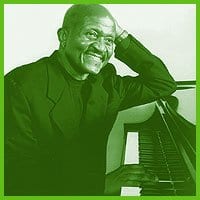Andy Bey has been around for a long time and he sounds as if he intends to be around for a lot longer. A critically celebrated jazz singer with five decades of professional history, Bey is an out gay man comfortable discussing his HIV status. The New Jersey native even has a Canadian connection: His sister is Salome Bey, the well-known and much loved musical star and Toronto resident.
Andy Bey was born in 1939 and became an entertainer early on, appearing as a vocalist and playing piano at Harlem’s legendary Apollo Theatre. He toured and recorded in the 1950s and into the ’60s with family members Salome and Geraldine as Andy Bey And The Bey Sisters. Many recording dates with the likes of Horace Silver and others took him through the ’70s and ’80s. As too often happens, he had to be “discovered” again in the ’90s, when producer Herb Jordan instigated a fruitful collaboration that has so far yielded four highly rated albums.
The latest of these appeared in 2004, with the underwhelming title American Song. Do not be put off by an unimaginative marketing department. Bey and his arrangers and musicians examine with sensitive insight an interesting and provocative collection of popular songs.
Anyone watching the sales charts or the Grammys is probably aware that Rod Stewart has recently released two albums featuring the standard popular song repertoire. While Stewart has essentially had to speak his versions, with backup singers and accompaniments arranged to hide the fact of his broken voice, Bey – some four years older than the aging Brit rocker – is still able to use his powerful and highly expressive voice to illuminate the great songs chosen for American Song. No fear of vocal failure here.
There are a number of highlights on this insightful collection that employs the piano and arranging talents of Geri Allan and some other fine jazz musicians. A great deal of careful thought has been given to the nature and history of each song performed. As an example, the relatively unused bass clarinet is featured in an arrangement of Duke Ellington’s “Prelude To A Kiss,” surely in homage to the great bass sax and clarinet player Harry Carney, a 40-year stalwart of the Ellington orchestra.
Ellington’s gay co-composer Billie Strayhorn’s work is well represented on this album. The wonderfully sophisticated gay lyrics of Strayhorn’s masterpiece “Lush Life” have rarely been heard to such effect as they are in Bey’s version. Bey’s piano playing on the Ellington/ Strayhorn melody “Satin Doll” invokes respectful echoes of the Duke’s own piano stylings.
Of Bey’s vocal and interpretive talents, writer David Ritz includes him in an explanation of what it means to be a great vocalist: “By personalizing every song, by infusing both words and music with their idiosyncratic character, the great singers become great composers. They rewrite the standards, casting themselves in the lead roles of startling new dramas. Few singers have that gift. Bey has it in abundance.”
AMERICAN SONG.
Andy Bey.
Savoy Jazz. $20.

 Why you can trust Xtra
Why you can trust Xtra


